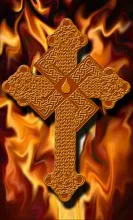This article  ran in The Barnes Review in May, 1996
ran in The Barnes Review in May, 1996
The 1933 International Boycott of Germany – Execution
By Udo Walendy
Udo Walendy is a German publisher and author best known for exposing propaganda photographs from the world wars as fakes, “doctored” to indict Germans and Germany. His revisionist work includes periodic publication of the magazine Historical Facts, D-4973 Vlotho/Weser, Postfach 1643, Germany.
By 1933 the German people had reached their limits of tolerance under the draconian terms of the Versailles Treaty. Nationalism was on the rise. It was immediately met with an internationally coordinated effort to crush Germany's economy and keep the people in perpetual poverty and subjugation.
Previously, in an article entitled “The Economic Boycott of Germany - Prelude” (TBR April, 1996), the organization of an international boycott against Germany was discussed. When Adolf Hitler was appointed chancellor in 1933, the handwriting was on the wall for the plutocratic European forces which had kept the German nation weak and its people in near-starvation conditions for 15 years. The re-emergence of Germany as a viable player on the international stage both in commerce and as a political power could not be allowed to happen.
Consequently, Jewish organizations outside of Germany set in motion an international boycott with the specific goal of bringing down the fledgling National Socialist government. Other groups, including religious and labor organizations, were recruited to help the effort.
 In this program we presented and discussed Fire in the Reichstag, by Peter Wainwright, which may be found at the Institute for Historical Review, and also Myths, Wartime Propaganda and the Burning of the Reichstag by Fred Blahut, which was published in the January, 1996 issue of The Barnes Review, the text of which is found below.
In this program we presented and discussed Fire in the Reichstag, by Peter Wainwright, which may be found at the Institute for Historical Review, and also Myths, Wartime Propaganda and the Burning of the Reichstag by Fred Blahut, which was published in the January, 1996 issue of The Barnes Review, the text of which is found below.





























